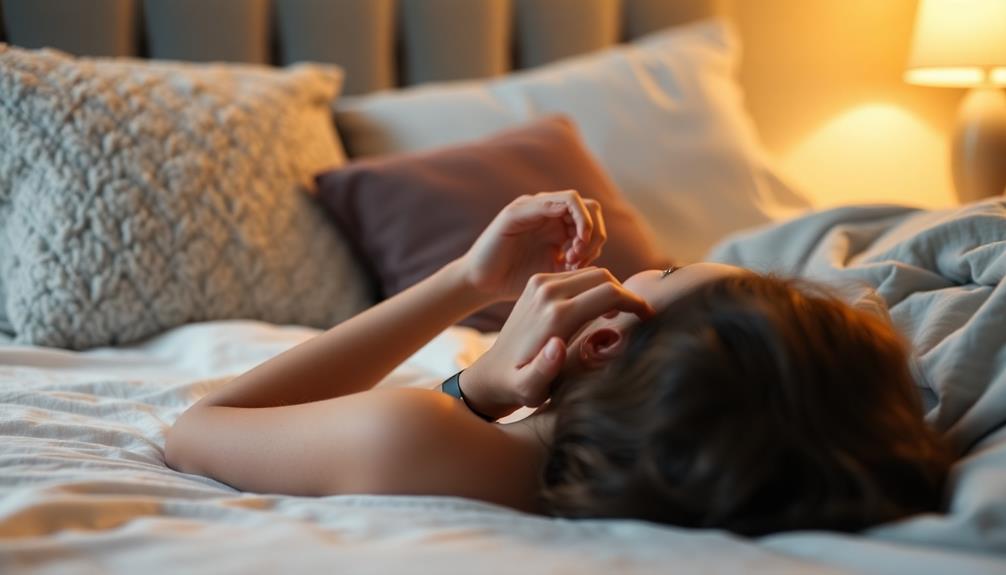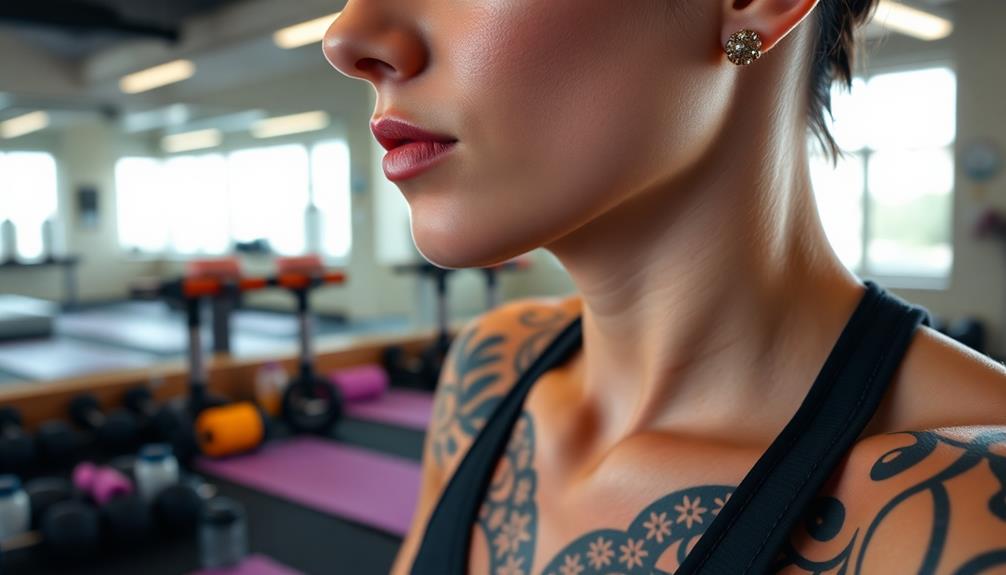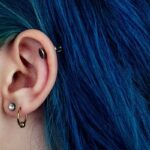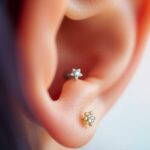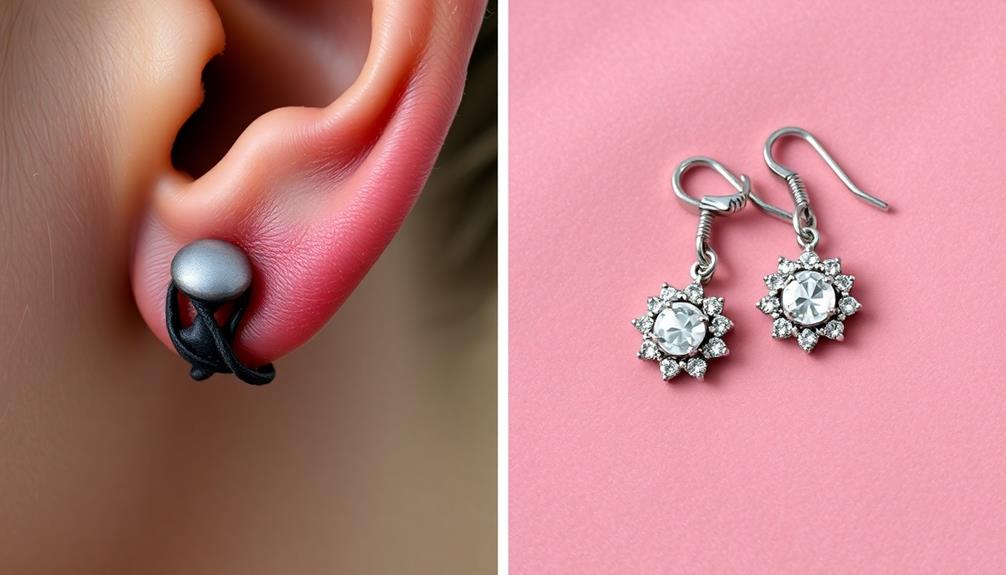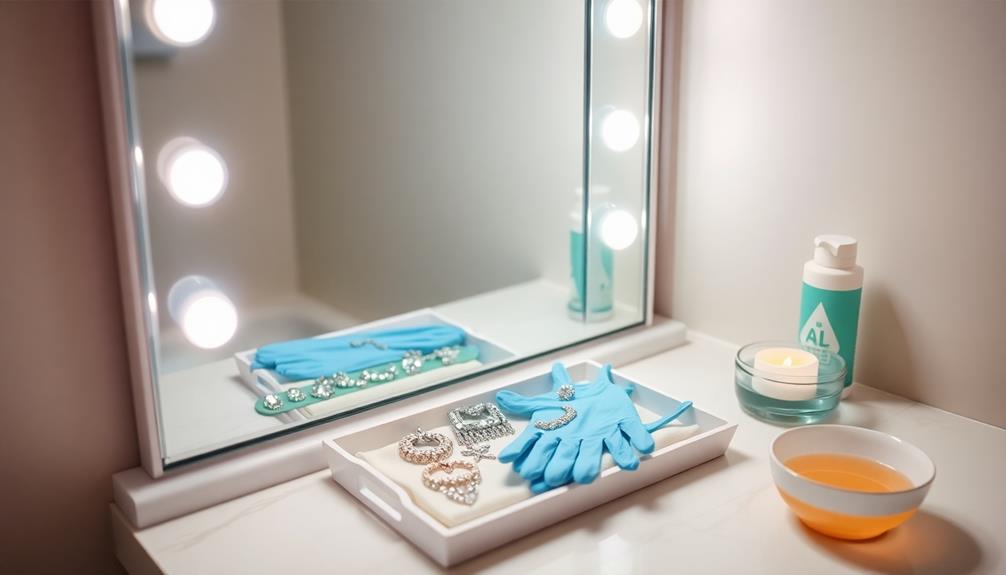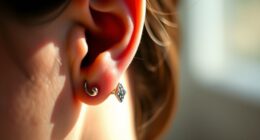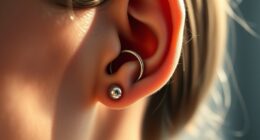To sleep comfortably with new piercings, start by choosing the right sleeping position; avoid lying on the side of your piercing. Instead, try sleeping on your back or using a U-shaped travel pillow to minimize pressure. Select small, flat earrings made of hypoallergenic materials like surgical steel or titanium to reduce discomfort. Keep your hair tied back to prevent tangling with jewelry and maintain proper hygiene by cleaning the piercings daily. Changing pillowcases regularly will also help. With these strategies, you can enhance your comfort while you heal, and there's plenty more to explore for ideal care.
Key Takeaways
- Sleep on your back or in a semi-upright position to minimize pressure on new piercings.
- Use supportive pillows like U-shaped or doughnut pillows to reduce friction on the piercing.
- Choose small, flat stud earrings made from hypoallergenic materials to decrease discomfort during sleep.
- Keep hair tied back to prevent tangling with jewelry and potential irritation.
- Clean piercings daily and change pillowcases regularly to maintain hygiene and promote healing.
Understanding Healing Times
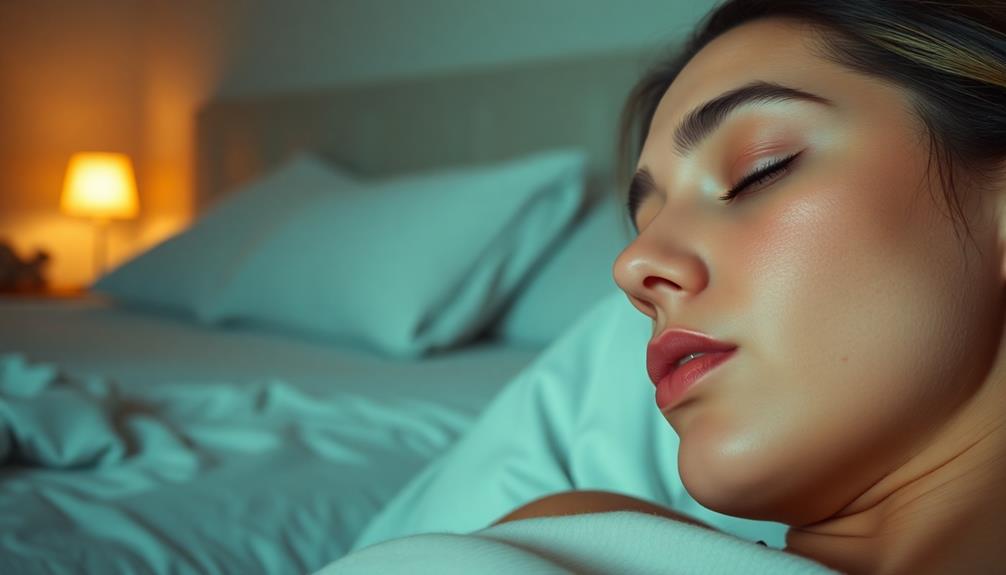
When it comes to understanding healing times for new piercings, knowing what to expect can make the process smoother for you. Earlobe piercings typically take about 6 to 8 weeks to fully heal, while cartilage piercings may take anywhere from 6 months to a year. The healing time varies based on the location of the piercing, with lobe piercings healing faster than cartilage ones.
During the healing process, it's essential to keep the piercing clean. Regular cleaning helps prevent infections, which can slow down healing. You'll want to monitor for signs of infection, like redness or swelling.
It's also significant to avoid putting pressure on the piercing, as this can irritate the area and prolong healing. Adhering to aftercare instructions is crucial. Keep your earrings in place for at least 6 weeks to prevent closure during the healing time.
Individual health and lifestyle factors can also impact how quickly your new piercings heal. By following these guidelines, you can guarantee a smoother and more efficient healing process for your new piercings.
Risks of Sleeping With Piercings
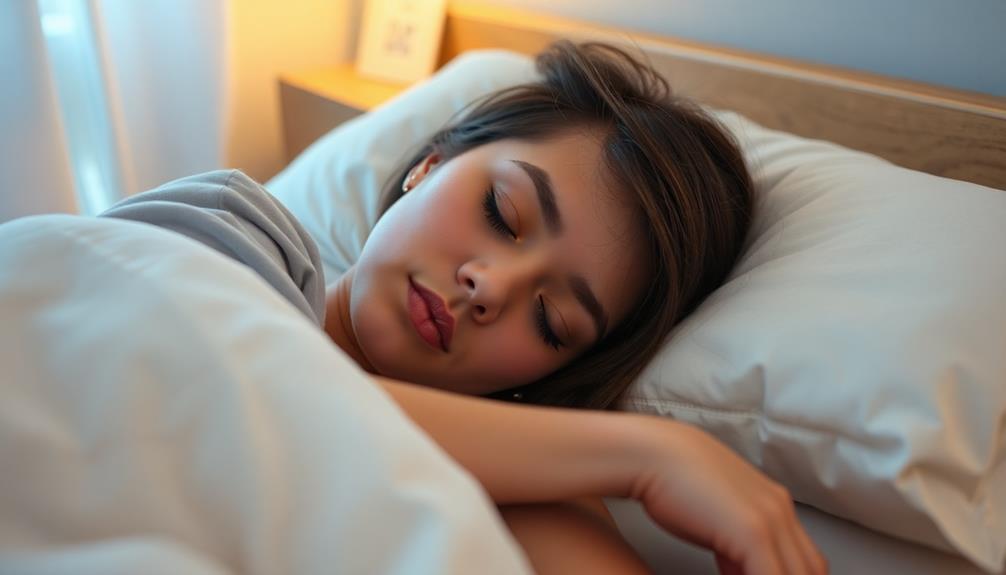
Sleeping with new piercings poses several risks that can complicate your healing process. These risks can lead to irritation and infection, making it essential to be aware of what you might encounter while you sleep.
- Risk of infection: Bacteria can easily get trapped against your skin, increasing the likelihood of complications if you sleep on the piercing.
- Pressure and friction: Bedding or movement during sleep can create unnecessary pressure and friction, leading to irritation and discomfort.
- Pain and discomfort: Certain sleeping positions may put pressure on the newly pierced area, disrupting your sleep quality and causing significant discomfort.
- Tearing of the skin around: If hair gets tangled in the jewelry or your piercing catches on fabric, it can tear the skin around the piercing, complicating the healing process.
Additionally, you might experience headaches from the pressure applied to the piercing site while you sleep.
To minimize these risks, it's best to avoid sleeping on the side with the new piercing until it's healed. By being mindful of these potential issues, you can promote a smoother healing journey.
Comfortable Sleeping Positions
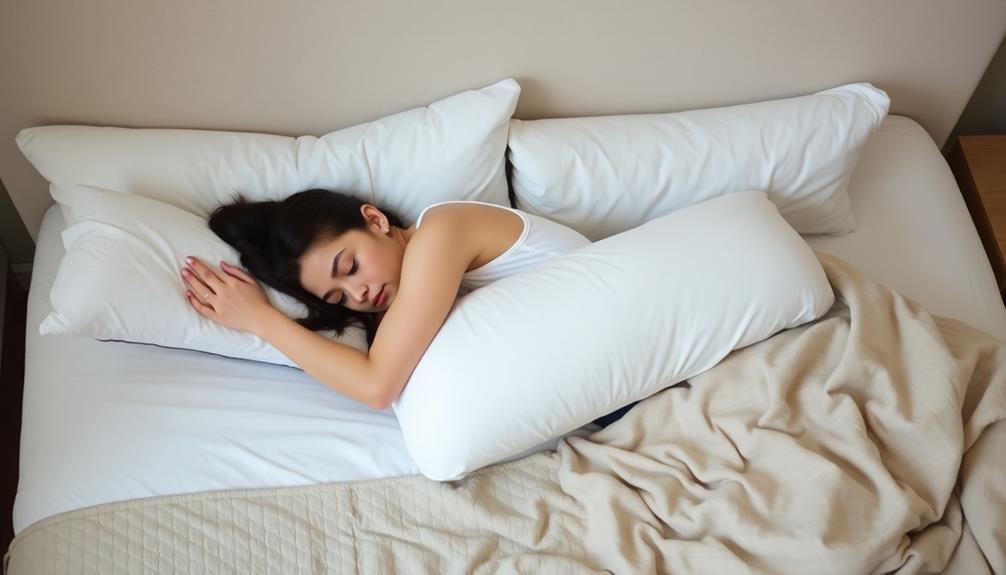
To guarantee a comfortable night's rest with new piercings, opt for sleeping positions that minimize pressure on the affected area.
It's best to sleep on your back or in a semi-upright position. This approach helps prevent discomfort and irritation during the healing process. Make sure to avoid sleeping on the side of your new piercing, as it can lead to increased pain and possible complications with healing.
Using a U-shaped travel pillow can be a game-changer. It provides additional support while creating a hollow space that prevents pressure on the pierced area.
Propping pillows around your body can also help maintain a comfortable position and keep you from rolling onto the side of your piercing during the night.
Additionally, remember to keep long hair tied back while sleeping. This simple step helps avoid tangling with your jewelry and reduces the risk of irritation or tearing around the piercing site.
Effective Piercing Care Tips
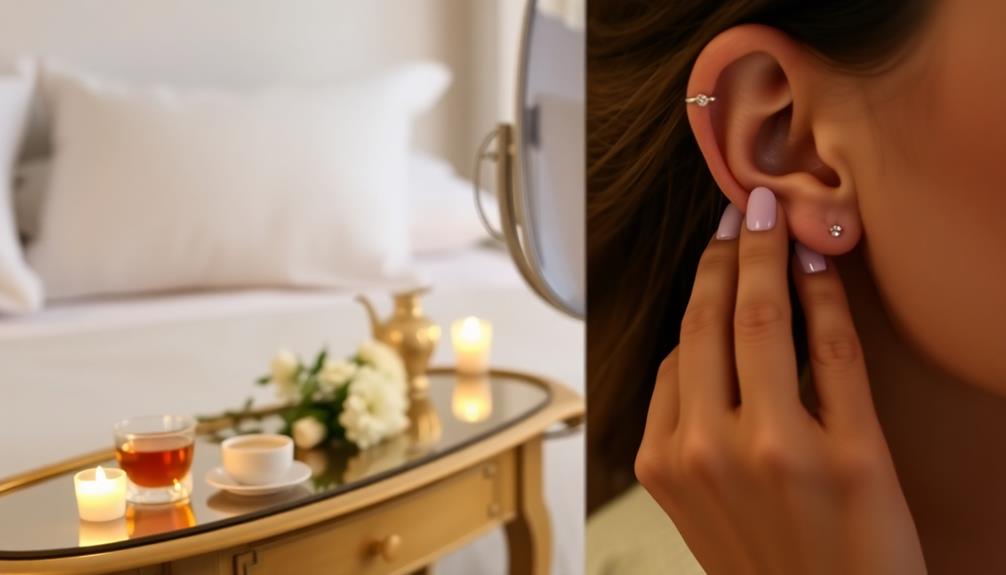
Taking care of your new piercings is essential right from the start to guarantee a smooth healing process. By following these effective piercing care tips, you can help prevent complications and promote healing.
- Clean the piercing: Use a sterile saline solution or fragrance-free soap to clean your piercing at least once daily. This helps prevent infection and keeps the area fresh.
- Avoid putting pressure: When sleeping or wearing clothing, make sure you don't put unnecessary pressure on the piercing. This can lead to irritation and prolong the healing process.
- Monitor for infection: Regularly check your piercing for any signs of infection, such as increased redness, swelling, or discharge. If these symptoms persist, consult a healthcare professional.
- Use hypoallergenic materials: Always choose jewelry made from hypoallergenic materials like surgical steel or titanium. This minimizes the risk of allergic reactions and helps reduce irritation during healing.
Jewelry Considerations for Comfort

When it comes to new piercings, choosing the right jewelry is essential for your comfort during sleep.
Opt for small, flat studs made from hypoallergenic materials to reduce irritation and avoid sharp edges that could cause pain.
Earring Material Selection
Choosing the right earring materials is essential for ensuring comfort while your new piercings heal. To minimize the risk of irritation and allergic reactions, focus on hypoallergenic materials that are gentle on your sensitive skin. Here are some options to take into account:
- Surgical steel – A safe and durable choice, surgical steel is resistant to corrosion and irritation.
- Titanium – Lightweight and strong, titanium is ideal for sensitive skin and helps with the healing process.
- 14k gold – If you prefer a bit of shine, opt for 14k gold, which is less likely to cause reactions than lower-quality gold.
- Avoid nickel – Make sure to steer clear of earrings containing nickel, as they can lead to rashes and inflammation.
When selecting earrings, choose small studs or even silicone plugs to reduce pressure while sleeping.
Remember, it's important to leave your earrings in until your piercing is fully healed—typically six weeks for earlobes and up to a year for cartilage.
If you can't remove your earrings, think about silicone covers for added comfort and protection against irritation.
Jewelry Size and Shape
The size and shape of your jewelry play a significant role in how comfortable you feel while sleeping with new piercings. Opt for small flat studs, as they minimize discomfort and pressure during sleep. Larger earrings can cause irritation and pain, making it tough to get a good night's rest.
Choose hypoallergenic materials like surgical steel or titanium to reduce the risk of allergic reactions and skin irritation around the piercing site.
Avoid twisting your jewelry while sleeping, as this can increase discomfort and prolong the healing process. Instead, consider using silicone plugs at night; they can help maintain your piercing while ensuring comfort.
When resting your head on a regular pillow, be mindful of how your earrings sit to prevent excessive pressure.
It's essential to keep your piercing clean and avoid changing your jewelry until it's fully healed. Premature changes can irritate the area and lead to complications that might require medical attention.
Avoiding Sharp Edges
To steer clear of discomfort while sleeping with new piercings, prioritize jewelry that features smooth, rounded edges. Sharp edges can dig into your skin, causing irritation and pain as you move during the night.
It's also essential to take into account the weight and materials of your jewelry, as lighter options can lessen pressure on your piercings. Here are some jewelry options that can enhance your comfort:
- Smooth, rounded earrings: These minimize the risk of discomfort and irritation.
- Flat studs: They sit close to the skin and won't catch on your pillow.
- Hypoallergenic materials: Opt for surgical steel or titanium to reduce allergic reactions and irritation around your piercings, especially important for those with sensitive skin natural styling products.
- Silicone plugs: They're soft and flexible, preventing sharp edges from causing discomfort while still keeping your piercings secure.
Hygiene Practices for Healing
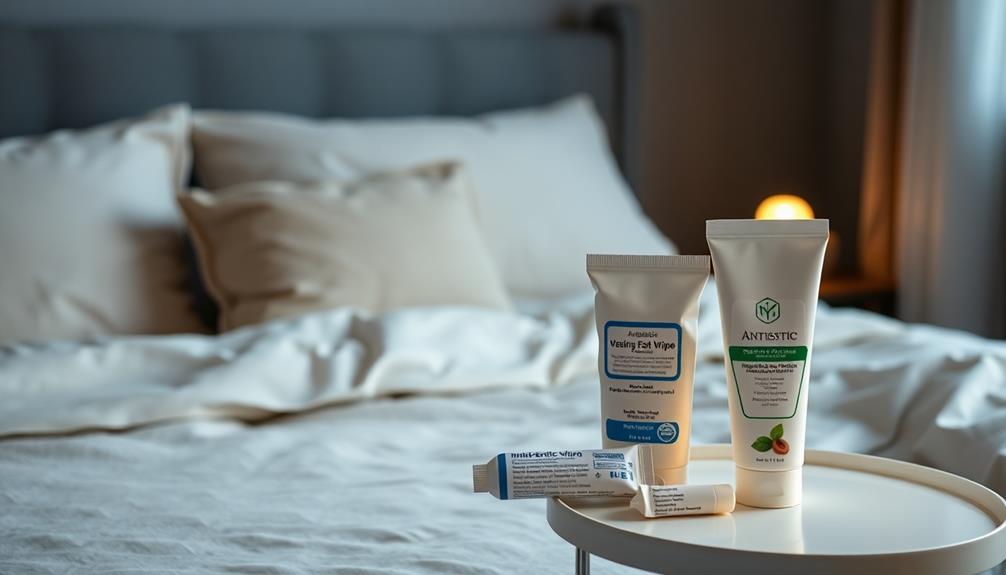
During the healing process of new piercings, maintaining proper hygiene is vital. Keeping your piercing clean can greatly reduce the risk of infection and promote healing. Here are some key practices to follow:
| Practice | Description |
|---|---|
| Clean the Piercing | Clean your piercing 2-3 times daily with a saline solution or gentle soap. |
| Change Pillowcases | Change your pillowcases every few days to minimize bacteria and dirt exposure. |
| Avoid Wet Hair | Avoid sleeping with wet hair to reduce the risk of bacteria entering the piercing. |
Additionally, it's important to verify the piercing area is free from harsh chemicals like chlorine or saltwater, which can irritate your skin. Stick to mild, fragrance-free cleaning products recommended by a healthcare professional to avoid irritation during the healing process. By following these hygiene practices, you'll help guarantee a smoother healing experience while you sleep comfortably with your new piercing.
Recommended Products for Comfort
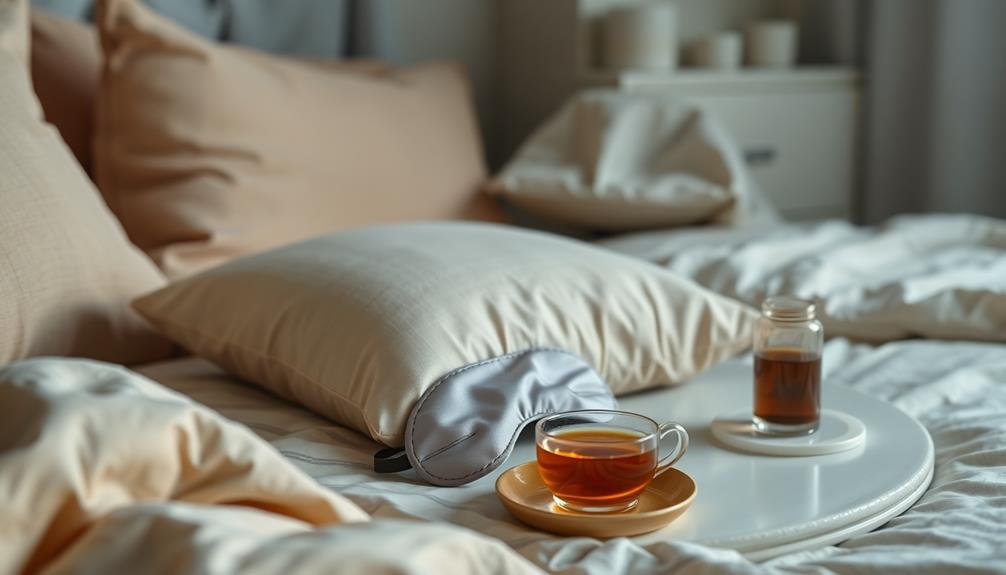
Choosing the right products can make a big difference in your comfort while sleeping with new piercings.
Consider options like the Original P.W.A.H.® V2 pillow or silicone plugs to support your healing process.
These products help minimize pressure and irritation, ensuring a more restful night.
Essential Pillow Options
Finding the right pillow can make all the difference when you're trying to sleep with new piercings. Here are some essential pillow options that can enhance your comfort during sleep and help reduce irritation:
- Original P.W.A.H.® V2: Designed for maximum support, this pillow minimizes pressure on newly pierced ears, making it perfect for both short and long-term use.
- Original Travel P.W.A.H.®: Compact and portable, this travel pillow guarantees you stay comfortable on the go while keeping your healing piercings protected.
- Doughnut P.W.A.H.®: This compact solution effectively reduces pressure on your ear, catering to various types of ear piercings.
- Original Pillowcase with a Hole™: Specifically crafted to allow your ear to rest without friction, this pillow promotes a better healing environment.
Additionally, consider investing in a waterproof wipe-clean P.W.A.H.® to maintain hygiene, especially if you're using creams or ointments on your piercings.
Choosing the right pillow can transform your sleep experience, providing the comfort you need while allowing your new piercings to heal properly.
Jewelry Considerations for Comfort
When it comes to sleeping comfortably with new piercings, the type of jewelry you choose plays a significant role. Opt for small, flat stud earrings to minimize pressure and discomfort during the night. Larger earrings can exacerbate irritation, so it's best to avoid them. Lightweight materials like titanium or surgical steel are ideal; they won't weigh down your ears and can help prevent pain.
Consider using silicone plugs at night. They provide a comfortable barrier against friction while maintaining the integrity of your new ear piercings. Remember, do not change your jewelry until your piercing is fully healed, which usually takes at least six weeks for standard lobes.
To further enhance your comfort, use a barrier cream around the piercing if your bedding or clothing comes into contact with the jewelry. This reduces irritation and promotes a better sleeping experience.
Here's a quick reference table for your jewelry choices:
| Jewelry Type | Material | Recommendations |
|---|---|---|
| Small Flat Studs | Titanium/Surgical Steel | Ideal for comfort |
| Silicone Plugs | Silicone | Prevents friction |
| Avoid Sharp Earrings | N/A | Prevent irritation |
| Barrier Cream | N/A | Reduces irritation |
Frequently Asked Questions
How to Sleep With Fresh Piercings?
To sleep with fresh piercings, lie on your back to avoid pressure. Use small studs, keep your bedding clean, and consider a travel pillow for comfort. Always clean your piercings before bed to promote healing.
How Long After Getting a Piercing Can You Sleep on It?
Did you know that nearly 50% of piercing complications arise from improper care? You should wait at least 6 weeks for earlobes and 3-4 months for cartilage before sleeping on a new piercing.
Is OK to Accidentally Sleep on a New Piercing?
It's not ideal to accidentally sleep on a new piercing. Doing so can cause irritation or infection. If you find yourself in that position, keep an eye out for any unusual symptoms.
Can Sleeping on a Piercing Irritate It?
Yes, sleeping on a piercing can irritate it. Pressure and friction may lead to discomfort, increased risk of infection, and prolonged healing. To avoid this, try sleeping on your back or using supportive pillows.
Conclusion
In the journey of healing your new piercings, think of yourself as a gardener tending to delicate seedlings. Just like those plants need the right environment to flourish, your piercings require care and attention for ideal healing. By choosing the right sleeping positions, maintaining hygiene, and selecting comfortable jewelry, you can nurture your new adornments. Remember, every night is a chance to give your piercings the rest they need to bloom beautifully in your life.
Hi, my name is Danielle, and I’m an author for piercings-body.com. I have a passion for writing and love to share my knowledge on all things body piercing-related. I’m also a huge advocate for safe body modification practices and believe everyone should be able to make informed decisions about their bodies. When I’m not writing or blogging, I enjoy spending time with my family and friends, practicing yoga, and exploring new places.

